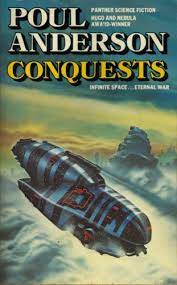(i) Venus is an Earth-sized planet with a cloudy atmosphere whereas the Moon is a much smaller planet with no atmosphere - although, according to the story, the Lunar surface is a quarter of Earth's land area.
(ii) Much more is known about Venus now than when Anderson wrote this story in the early 1960's. He thought that human beings would be able to live on Venus while terraforming it. Photosynthesizing algae were seeded in the upper atmosphere. When the temperature dropped to below one hundred, it rained for ten years and liquid water made rock consume carbon dioxide until there was breathable air. Then solar protons and ultraviolet radiation broke down hydrogen compounds. It will not be as easy as this to change the Venerian atmosphere or reduce its temperature.
On the Moon, the terraformers use deep wells and nuclear explosions to cause vulcanism, the process that gives terrestroid planets their atmospheres by releasing buried water and breaking minerals and organics into carbon, nitrogen and sulphur compounds. Gravity is low but air loss is slow. Already the Moon looks different from Earth - desecration according to some.
Anderson tells us the science, then the politics. The Lunar project is opposed as an expensive diversion of resources from Earth. Politics leads to the action-adventure fiction of sabotage, kidnapping, characters holding each other at gunpoint, escape, pursuit etc. Since I am still reading the story, I have yet to learn either the significance of its title or how it fits into the war-themed collection, Conquests.
Venus dwellers are called Cythereans and have developed a clan system which sounds familiar from the Psychotechnic History story earlier in this collection. Until now, I would have dipped into a collection like Conquests for individual stories and not necessarily have read them all. For posting purposes, I have for the first time read the collection from cover nearly to cover and appreciated seven stories that have been collected together because of their shared theme. Kind of a new reading experience, to be followed by other collections and by a posthumous novel in the post.

5 comments:
Hi, Paul!
Hmmm, meaning Anderson speculated mistakenly about humans living on Venus too soon after terrafoming started? I can see how errors would be made due to him basing his works on what was then known.
Most of what I know about how Venus might be terraformed came from reading Anderson's story "The Big Rain" and Jerry Pournelle's non fictional essay of the same title (written in 1975 and republished in A STEP FARTHER OUT in 1979.
I think STEP is one book all SF fans snd persons interested in regaining boldness and openness to new life in our civilization should have. Pournelle offers many ideas and suggestions for resolving many of the problems of our times. Alth old, the articles in STEP are still relevant because so much of what he advocates has not even been tried, so we don't know if they would work or not. It's my view the UK and US have chosen diastrously bad paths away from space and limited gov't.
Sean
Terraforming Venus would require importing enough water (or maybe just the hydrogen) to make a modest ocean, from elsewhere in the solar system. I don't see how that could be done in less than many millennia. An easier part of the job would be making a 'flock' of solar sails between Venus & the sun to cool the planet somewhat while also cutting the amount of CO2 in the atmosphere to also reduce the temperature.
However, people could live in balloon habitats before & during the terraforming. High up in the atmosphere the temperature & pressure are both close to earth sea level conditions. A breathable oxygen nitrogen mix is less dense than the mostly CO2 atmosphere, so that is all that is needed to keep the balloon habitat aloft.
Since Venus has about 90% the gravity of earth, the difference is very unlikely to cause health problems. We have no data to tell us whether humans can maintain good health at lunar or martian gravity. If not terraforming either one has no benefit until humans can be modified to live at lower gravity.
I'm inclined to think the O'Neill style rotating space habitats are where most off earth humans will live.
Kaor, Jim!
Very interesting comments about the terraforming of Venus. I don't claim to know enough about this to judge if you are right or wrong about it first being necessary to bring a huge amount of water (or at least the hydrogen) before the process could be started. If they were still alive, I'm sure either Anderson or Pournelle could have commented knowledgeably.
A planet with a gravity ninety percent that of Earth's would be more than enough for humans to live on comfortably, assuming liquid water and a breathable atmosphere. In his stories we see Anderson speculating about humans living on Mars with no serious problems despite a gravity only 37 percent that of Earth's, or on Imhotep (in THE GAME OF EMPIRE), despite its gravity being 30 percent heavier than Terra's. I think humans will be perfectly capable of colonizing terrestroid planets with gravities in those ranges!
I like O'Neill habitats, and I hope they will be built, but I don't believe they will be the only options for humans living off Earth.
Ad astra! Sean
I really want to see a moon base built so we can find out if living on bodies with substantially less than earth gravity is an option.
Experience on the ISS tells us that long term zero gee living isn't an option.
Kaor, Jim!
And Poul Anderson examined such questions in his HARVEST OF STARS books, including whether or not the low gravity of the Moon would prevent women from successfully bearing children there.
Ad astra! Sean
Post a Comment